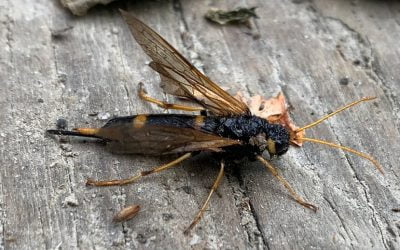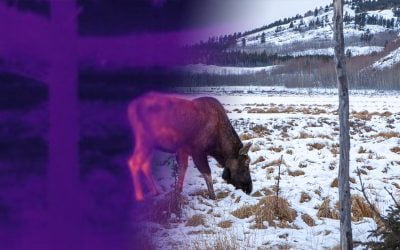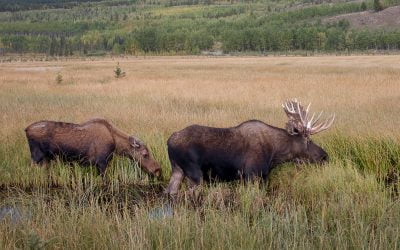
News / Blog
Browse all articles:
Vernal Species Migration
11 min read - Part of Nature’s plan involves animals moving to new locations for two primary reasons:. One is seasonal migration when animals move to a summer location principally to give birth and raise offspring, and the other is permanent migration or colonized...
Annual Report for 2020-21
Contents About the Preserve in 2020-21 President's Report Executive Director's Report Ex-Officio Report Operations Report Animal Care Report Wildlife Rehabilitation Report Visitors Services Report Education and Programing Report The Preserve in 2021-22 Virtual AGM...
Surviving a Cold Snap
15 minute read - This is Part 3 of a 4 part series by guest author and ecologist, Joshua Robertson on how wildlife at the Yukon Wildlife Preserve stays warm (thermoregulates) in the winter. Read Part 1: Staying Warm in the Yukon and Part 2: Winter Heat Losses. Preface...
The Boreal Forest – A Life Source
11 min read - A key feature of the Yukon’s geography is the Boreal Forest. The Boreal forest grows around the Earth located exclusively in Northern Hemispheres at latitudes between the Arctic Circle and 50° North....
Uneasy neighbours: red foxes and arctic foxes in the north
It’s tough out there in the arctic. It’s a real fox-eat-fox world. Literally! Take a virtual trip up to the Yukon’s arctic coast and learn about the complex and, at times, tenuous co-existence of two northern icons: the red and arctic fox.
The Dangerous and the Benign: distinguishing between big scary bugs
Some participants of the 2020 Bioblitz got a bit of a scare when they discovered a large insect with what appeared to be a massive stinger. Since Asian giant hornets aka “murder hornets” had recently made headlines with their unwelcome appearance on the west coast of North America, it was reasonable to worry that they may have traveled north to our territory. But we are here to squash that fear! The big scary bug you may be spotting in your backyard is neither murderous nor a hornet. It also doesn’t actually have a stinger! Learn about the harmless wood-loving horntail and how it couldn’t be more different than the dangerous hornet it was mistaken for.
Bear Poo and You: learning about Yukon Bears with the OURS research project
People say there’s more than one way to skin a cat but there’s also more than one way to survey a bear. One of those ways is through their scat! Operation Ursus Research using Scat is doing exactly this and you can be a part of it. Learn how these surveys are conducted, why they’re important, and how you can help improve our knowledge of Yukon bears by collecting their poo.
Rusty Blackbird: the mysterious decline of a common boreal bird
The aptly named Rusty Blackbird is regular fixture in the boreal forest and can often be spotted in wetlands and hanging out by slow moving streams. Until recently, very little was known about this opportunistic water-loving bird but as we learn more about them, we’ve also learned that their populations are in decline. What’s causing this drop in Rusty Blackbird numbers? We’re not entirely sure. Read on to learn how scientists are using modern
technology and recent discoveries to help unravel this mystery. Written by Pam Sinclair in conjunction with Joelle Ingram
Winter Heat Losses
15 minute read -This is Part 2 of a 4 part series by guest author and ecologist, Joshua Robertson on how wildlife at the Yukon Wildlife Presere stays warm (thermoregulates) in the winter. Read Part 1. The article was edited on March 15, 2021 to update heat loss...
Staying Warm in Yukon
10 minute read - This is Part 1 of a 4 part series by guest author and ecologist, Joshua Robertson on how wildlife at the Yukon Wildlife Presere stays warm (thermoregulates) in the winter.In the south of the Yukon, winter has long since settled in. Snow has...
Love for the Lynx
While the ungulates have already gone through their languages of love the carnivores are just getting started!
It’s a great time to hear the courtship calls from the lynx, arctic fox and red foxes. While the two species of foxes are the same gender (red foxes – males, arctic foxes – females), our lynx group consists of a male and two females and all three lynx will remain in the habitat together this season.
Language of Love
15 minute read and listen - With Valentine’s Day around the corner, we all have love on the brain... at least us humans do. Here at the Preserve the ungulates have already gone through their respective courtship rituals back in the fall. Nonetheless, it seems like a...
Media Statements
- Male Moose at YWP – 2025-08-08
- ATCO Employees Donation – YWPOS – 2025-05-20
- Orphaned Moose Calves at YWP – YWPOS – 2023-07-25 Update.pdf
- Arctic Fox Passes Away – YWPOS – 2023-07-25.pdf
- Orphaned Moose Calves at YWP – YWPOS – 2023-07-07.pdf
- Male Lynx Passes Away – YWPOS – 2022-12-02.pdf
- Muskox Calf Passes Away – YWPOS – 2022-04-13.pdf
- Male Lynx Kitten Passes Away – YWPOS – 2021-12-10.pdf
- Young Female Lynx Passes Away – YWPOS – 2021-11-05.pdf
- Young Male Moose at YWP – YWPOS – 2021-05-26.pdf
- Moose Calf Passing – YWPOS – 2019-07-15.pdf
- YWP to Receive Large Donation 2019-08-14.pdf

Box 20191
Whitehorse, Yukon
Y1A 7A2














